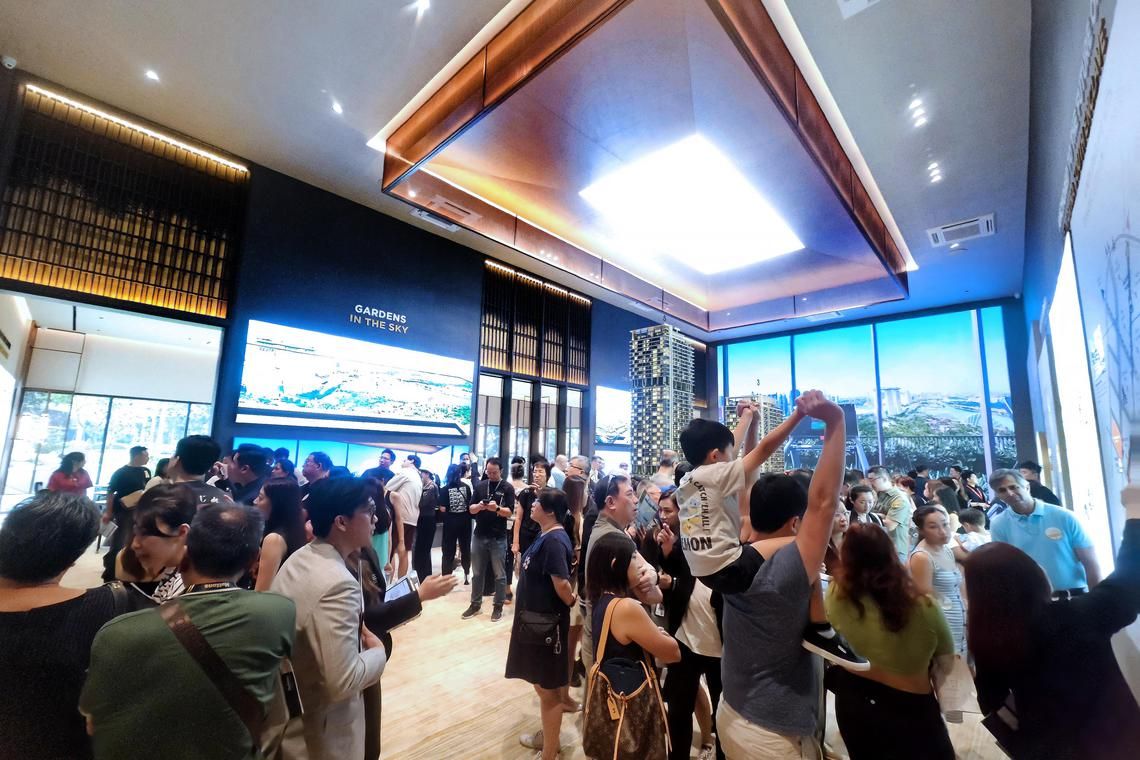SINGAPORE – April’s new private home sales fell short of expectations despite a surge in the number of new launched units, as home buyers turned cautious amid ongoing global trade frictions and geopolitical tensions that have dampened Singapore’s economic outlook.
New private home sales slipped to 663 units in April from 729 in March, also on a dearth of major mass-market new launches, but more than double the 301 units sold in April 2024.
Excluding executive condominiums (ECs), 1,344 new units were launched in April, compared with just 555 units in March, and up from a mere 278 units launched in April 2024. Including ECs, new home sales plunged to 759 in April from 1,510 in March, while the number of new units launched rose to 1,344 units from 1,315 over the same period.
April’s three new projects – One Marina Gardens, Bloomsbury Residences in Media Circle and the ultra-luxe 21 Anderson in Tanglin – are situated in city fringe and prime locations where launch prices tend to be higher, according to OrangeTee’s chief researcher and strategist Christine Sun.
The median price of the 937 unit-One Marina Gardens was at $2,948 psf, while that of the 358 unit-Bloomsbury Residences was at $2,454, and 21 Anderson, which has 19 units, was at $4,811. This is well above the median price of a major suburban new launch – Lentor Central Residences at $2213 psf in March, Ms Sun noted.
Ms Tricia Song, CBRE’s head of research for Singapore and South-east Asia, noted that “most new launches for the rest of 2025 will be from the prime and city fringe submarkets, which have higher price points and may not generate the same kind of volumes as that from the attractively priced and voluminous suburban projects in first quarter 2025”.
The momentum in private home price growth could “plateau in the next few quarters on a weaker economic outlook” as Singapore’s 2025 GDP growth forecast was slashed to between zero and 2 per cent growth from an initial 1 per cent to 3 per cent growth as at April 14, she added.
As such, going forward, developers may choose to wait out the heightened economic uncertainty and delay their launches until there is more clarity on global trade and the economic outlook, Ms Song said.
“Despite One Marina Gardens’ relatively attractive price point compared to existing launches in the Downtown Core and high-floor units offering views of Gardens by the Bay, the project was met with a lukewarm response,” she said.
About 41 per cent or 384 units were moved in April, compared with earlier major launches in the first quarter in 2025, which recorded an average sell-through rate of 68 per cent over their launch weekends, she added.
Although the take-up rates for April’s new launches paled in comparison with some projects in the first quarter, Ms Wong Siew Ying, PropNex head of research and content, said One Marina Gardens’ sales have been commendable, in light of trade war tensions and as the project is not near schools or HDB estates, where there are a ready pool of HDB upgraders.
ERA Singapore chief executive Marcus Chu noted that One Marina Gardens and Bloomsbury Residences are situated in precincts that attract more investor interest rather than owner-occupiers, while 21 Anderson catered to high-net-worth individuals seeking freehold, large-format units.
In April, the priciest new homes sold were all at 21 Anderson, PropNex noted.
“Three units were transacted at around $21 million to $23 million each, making them one of the highest-valued new condo deals in 2025 – just after a unit at Park Nova that fetched nearly $38.9 million ($6,593 psf) in January. Of the three units sold, two were purchased by Singapore PRs and one by a Singaporean buyer,” Ms Wong noted.
Mr Lee Sze Teck, senior director of data analytics at Huttons Asia, pointed out that one unit at 21 Anderson “achieved a selling price of $5,127 psf, reflecting the confidence that ultra high-net-worth individuals have in Singapore’s status as a safe haven in times of instability.”
Also supporting the private housing market are strong household balance sheets and still-low unsold inventory, which stood at 18,125 units, excluding ECs, in the first quarter. This compared with 29,149 unsold, uncompleted units in first quarter 2020 when the Covid-19 pandemic struck, and at around 43,000 units in 2008 amid the global financial crisis.
Join ST’s WhatsApp Channel and get the latest news and must-reads.

